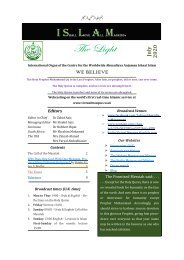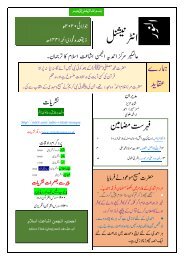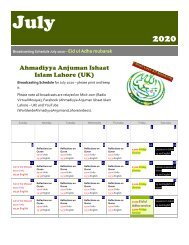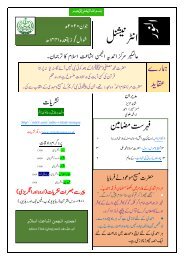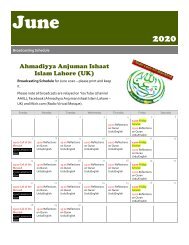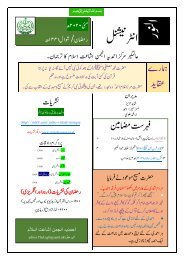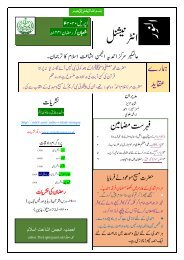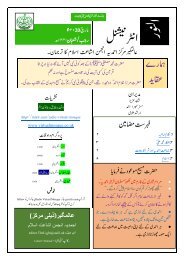2017 01 The Light January 2017
The Call of the Messiah 1 Submission and Sacrifice – II By Dr Jawad Ahmad 2 The Early Legacies of Mirza Ghulam Ahmad and the Lahore Ahmadiyya Movement in America By Patrick Bowen Ph.D. 7 A message for the Jalsa By Iain Dixon 11 Readers’ Comments 12
The Call of the Messiah 1
Submission and Sacrifice – II By Dr Jawad Ahmad 2
The Early Legacies of Mirza Ghulam Ahmad and the Lahore Ahmadiyya
Movement in America By Patrick Bowen Ph.D. 7
A message for the Jalsa By Iain Dixon 11
Readers’ Comments 12
Create successful ePaper yourself
Turn your PDF publications into a flip-book with our unique Google optimized e-Paper software.
<strong>January</strong><br />
<strong>2<strong>01</strong>7</strong><br />
<strong>The</strong> <strong>Light</strong> 8<br />
potential repercussions if Americans converted<br />
to Islam, Webb’s Islamic movement never<br />
gained mass popularity. Webb, therefore, retired<br />
to a quiet life in America, although he<br />
maintained his connections with Muslims<br />
throughout the world, including the Ahmadiyya,<br />
for whom, in 1910, he helped with the revision<br />
of Mirza Ghulam Ahmad’s book <strong>The</strong><br />
Teachings of Islam.<br />
As I have stated, Webb’s connections<br />
with the Ahmadi community are fairly well<br />
known to scholars, but there are also a few less<br />
well-known ties between Americans and Mirza<br />
Ghulam Ahmad during this same period. One of<br />
the most fascinating possible connections appeared<br />
during the same time and at nearly the<br />
same location that Webb first took an interest in<br />
Islam. It seems that Mirza Ghulam Ahmad’s<br />
first exposure to Americans came by way of<br />
an article published in 1886 in a journal for<br />
members of the <strong>The</strong>osophical Society, a liberal<br />
spiritual organization that was devoted to<br />
studying the various religions of the world.<br />
Webb was a member of this organization at the<br />
time, and it seems to have served as the intellectual<br />
and organizational model for his later Islamic<br />
movement. Interestingly, though, an acquaintance<br />
of Webb who was also in the <strong>The</strong>osophical<br />
Society - a man named Thomas Johnson<br />
- may have similarly been inspired by the<br />
article about Mirza Ghulam Ahmad, for in early<br />
1887 he established his own organization devoted<br />
to studying Sufism, or Islamic mysticism -<br />
which had been precisely one of the key elements<br />
of Islam Mirza Ghulam Ahmad was promoting<br />
at the time. Johnson’s group, known as<br />
the Sufic Circle, was the first Sufi organization<br />
in the United States, and it may have influenced<br />
later Sufi movements that were to spread in<br />
America and throughout Europe.<br />
A small number of other Americans seem to<br />
have been linked with the Ahmadiyya movement<br />
during these early years as well. According<br />
to Ahmadi sources, a physician and follower<br />
of Webb, Dr. Anthony George Baker, embraced<br />
Islam directly through correspondence<br />
with Mirza Ghulam Ahmad. In addition,<br />
a man from New York named F.L. Andersen,<br />
I Shall Love All Mankind.<br />
who began corresponding with Mirza Ghulam<br />
Ahmad in 19<strong>01</strong>, was soon being promoted<br />
as the first true Ahmadi convert in<br />
America. Andersen remained committed to the<br />
Ahmadiyya cause for the next thirty years;<br />
however he became devoted to the Qadian faction,<br />
which made a strong effort to promote Islam<br />
to Americans during the 1920s.<br />
<strong>The</strong> Lahore-based Ahmadiyya Movement,<br />
however, does not seem to have made clear inroads<br />
in the United States until the early 1930s,<br />
and this represents the second period of links<br />
between the Americans and Ahmadis. Like in<br />
the previous era, this period’s Ahmadi influence<br />
came not from Ahmadiyya representatives who<br />
were physically present in the country, but rather<br />
from overseas missionaries. At the time,<br />
the Muslim mission in Woking, England was being<br />
significantly influenced by the Ahmadiyya<br />
Movement of Lahore, and it was that community<br />
that was publishing one of the first widely<br />
popular English-language Islamic journals to be<br />
read in the United States. In fact, the editors of<br />
the Islamic Review appear to have made a strong<br />
push to promote both their magazine and Islam<br />
itself during the early 1930s. Letters published<br />
in the journal reveal that it was being sent to libraries<br />
and schools across the country and, in<br />
the process, was stimulating American interest<br />
in the religion.<br />
Perhaps one of the most surprising, if littleknown,<br />
outcomes of this particular Ahmadi effort<br />
is that the magazine’s tendency to publish<br />
letters from Americans made other Americans<br />
aware of their presence, which in turn helped<br />
bring together various American Muslim<br />
convert-focused organizations. <strong>The</strong> earliest<br />
example of this is the case of the white converts<br />
in Los Angeles, California, who read about each<br />
other in the magazine’s 1931 and 1932 issues.<br />
By the summer of the latter year, white Muslims<br />
in the region who had met each other through<br />
the journal began to organize. <strong>The</strong>n, in the<br />
following year, a small, but nationally-focused<br />
Muslim organization named the American<br />
Islamic Association used the Islamic Review<br />
to recruit the West Coast converts into its<br />
East Coast-based network. <strong>The</strong> American<br />
Islamic Association had been indirectly linked




